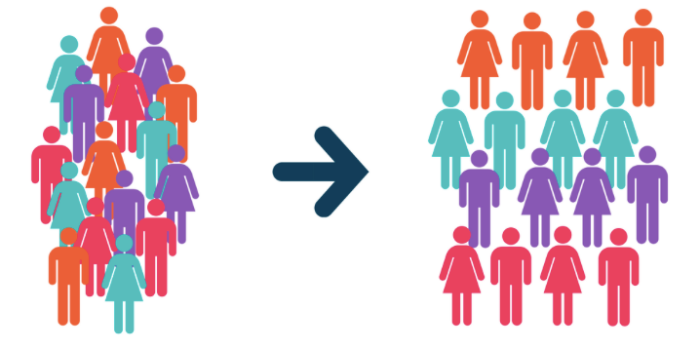1. Hyper customer segmentation
Utilizing data to achieve granular-level customer segmentation stands out as the typical retail analytics use case. There is no doubt that customers now are expecting more tailored shopping experiences. Therefore, leveraging big data for better customer segmentation could be the top alternative for you to perform better across all sales channels, and make better interactions with customer through diverse touch-points.
Retailers may then group customers together easier based on their preferences and purchasing behaviors, with the aim of simple aggregates and demographic breakdowns by applying cross-channel data. Retailers can more accurately identify target demographics for promotions or campaigns, and raise overall customer happiness by creating the highly targeted, detailed consumer segmentation.

For example, businesses like Neobank Northmill have increased conversions by 30% by using customer segmentation to tailor the retail banking experience.
2. Personalized marketing campaigns
As mentioned above, by classifying clients based on specified (generic) criteria, segmentation serves as a framework. Meanwhile, based on each customer’s particular requirements, wants, and motivations, personalization enables firms to engage with them on an individual basis. As a result, from customer segmentation, retailers can group customers into respective groups and create specific marketing campaigns for each targeted group.

But they understand them deeply by tracking their behaviors carefully
It is simple to start examining customers on a more in-depth level with a wealth of data. With the use of predictive analytics, the marketing process may be customized rather than launching a massive, expensive campaign with little impact or reach. You may control the content, when it is presented, and how and when it is displayed by providing more targeted messages. This increases efficiency and ROI while enhancing the customer experience and building loyalty.
The most well-known example of retail analytics of how effective it could be is Target’s pregnancy forecasts. Target statisticians were able to identify pregnancies by examining a customer’s purchasing patterns. The retailer may then give them vouchers for goods relating to babies to entice them to visit the store. Modern analytics algorithms can complete similar tasks much more quickly and on a much greater scale.
3. Automated marketing campaigns
Retailers are automating procedures more frequently to cut expenses and running costs. Retail marketing is no different. Retail marketing automation, however, offers a potent chance to boost consumer engagement, loyalty, and profit, in addition to its financial advantages. Big data and the proper retail marketing analytics tools are all you need to unleash it.
Retailers may send individualized messages to their customers and effectively advertise their items by using data-driven marketing tools like email campaigns and social media adverts. In a perfect world, these would be a part of a modern data stack where reverse ETL operations could be utilized to sync insights and initiate actions between marketing tools and a cloud data platform.

with automated marketing email campaigns
One outstanding example of analytics use cases in retail is how Sephora makes targeted product suggestions and discounts based on user data. With their VIB (Very Important Beauty) Program, Sephora succeeds at giving consumers who spend a particular amount of money early access to new goods and exclusive promos. After making the required purchase, a person is added to the VIB part of the email list and is immediately sent an email presenting the VIB program.
4. Price optimization
For sustained sales, competitive product price is essential but for retailers, pricing is a narrow line to walk. Finding the ideal pricing point is a delicate balancing act due to ongoing supply chain delays, rising shipping prices, and personnel issues. The too-low number might lead to the fact that businesses losing potential revenue, but the too-high number would risk losing customers.
That is why the application of business analytics in retail industry really matters. Retailers may determine which prices are most likely to yield the most profits and adapt these as soon as the market changes by leveraging real-time pricing data from rivals, sales data, and other data sources. This enables them to set up the best price structures across channels in order to increase potential income.
Vendors may better monitor customers’ staying periods within stores and provide promotional messages via dynamic signage that is tailored to particular demographics by adopting video analytics systems. These technologies also give merchants the useful information they require to develop in-store merchandising strategies that maximize sales volume depending on pricing and location.
5. Supply chain optimization
In supply chains nowadays, analytics are applied in a number of different ways. In other words, supply chains may function more smoothly and effectively with the use of data analytics.
Retailers can find patterns and trends to forecast future demands of supply chains by looking at data from previous shipments. They may better manage their inventories and prevent interruptions and stock-outs as a result. Data analytics may also assist supply networks in tracking their performance over time and optimizing their timetables and routes.
The operational costs of businesses can be decreased through other uses of data analytics in retail. According to studies, adopting supply chain management analytics has resulted in operating margin reductions of 60% for some businesses.
Due in part to decreased production volume for three months and a lengthy ramp-up period, Nike, a footwear manufacturer and retailer, has been severely impacted by the supply chain problems that deeply hurt the consumer goods and retail industries. Then Nike used retail analytics to streamline their supply chain in their distribution hubs, reducing delivery times and increasing customer satisfaction.

6. Inventory management
Any company that wishes to streamline operations and cut expenses must put a high priority on inventory management. Through more intelligent demand sensing, data analytics may significantly contribute to lower inventory costs. Businesses may better understand client demand patterns by examining historical sales data and trends. The future demand may therefore be predicted with more accuracy using this knowledge, and inventory levels can be adjusted accordingly.
Data analytics may also aid companies in identifying inefficiencies in their inventory management procedures and implementing improvements to enhance overall performance. Data analytics may assist companies in gaining a competitive advantage and enhancing their bottom line.
For instance, in the early stages of the pandemic, Canadian Tire employed self-service BI to swiftly recognize shifting client demands and adjust inventories. In the end, they managed to increase sales by 20% even if quarantine forced the closure of 40% of their brick-and-mortar outlets.
7. Fraud detection
Fraud may have a significant negative impact on retailers, deteriorating consumer relations and reducing revenue. So with the aim of shielding both the client and the company from possible losses, merchandisers need to predict and identify fraudulent transactions one step ahead by taking advantage of big data.
When the detection models are integrated into a business intelligence platform that enables risk managers and fraud detection teams to examine data, illustrate discoveries, and share information with other teams, these fraud detection systems are at their most effective.
Today, both shops and banks may utilize data analytics to prevent fraud. Rising e-commerce raises the possibility of fraud during the checkout or return process, but data analytics tools can identify which situations are legitimate and which are probably fraudulent.
A fashion retailer’s analytics system identified 93 separate orders traveling to the same address, protecting $10,000 worth of items from fraud. Although humans might be able to recognize these warning signs, analytics tools can do so far more quickly, stopping problems before they cause losses.
8. Scouting new store locations
Finding the best locations for a new store is a less well-known but very useful application of analytics in retail. It might be difficult and time-consuming to manually research things like land prices, regional demand, neighborhood demographics, and other things. It can be automated using data analytics tools, locating the ideal location for a new business in the shortest amount of time.
Geospatial data analytics are adapted successfully by Wendy’s and Starbucks, as they have identified their new lucrative locations. Their algorithms analyze a variety of factors to decide which regions have the most potential, including traffic patterns, average income, and surrounding businesses.
- Suggested for you: 6 Use Cases Of Prescriptive Retail Analytics (Examples Included)
9. Demand forecasting
With similar statistics that enable targeted marketing campaigns, the forecast for demand is certainly achievable. Seasonal trends will become evident as you collect data over time. By analyzing these historical statistics, you may anticipate when future shifts of this kind will occur and adjust your inventory accordingly.
Nestlé was able to reduce inventory by millions of dollars by relying on analytics rather than human judgment when estimating demand. Beyond seasonal patterns, the algorithm ran “what-if” scenarios based on numerous demand indicators. They were dependable, allowing Nestlé to halve their inventory safety supply.
Wrapping up
Without a doubt, the use of data analytics in retail is necessary in today’s business. It empowers retailers to comprehensively understand customer behavior, enabling them to make wiser business decisions. Big data separates the top performers from those that fall short of standing out, even though it may not yet be essential to a company’s success.
If you are a retailer, trying to enter the big data world for the first time, do not hesitate to contact Synodus for a free consulting session to build up your own appropriate development strategy.
More related posts from Data analytics you shouldn’t skip:
- 10 Ways To Apply Predictive Analytics In Retail
- 7 Retail Analytics Challenges And How To Overcome Them
How useful was this post?
Click on a star to rate it!
Average rating / 5. Vote count:
No votes so far! Be the first to rate this post.




